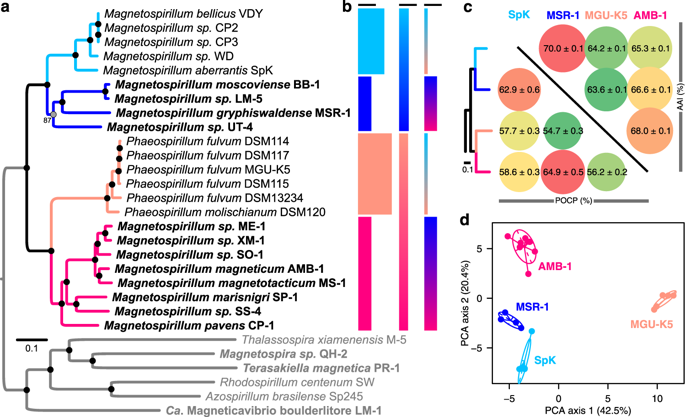Our official English website, www.x-mol.net, welcomes your feedback! (Note: you will need to create a separate account there.)
Repeated horizontal gene transfers triggered parallel evolution of magnetotaxis in two evolutionary divergent lineages of magnetotactic bacteria.
The ISME Journal ( IF 11.0 ) Pub Date : 2020-04-15 , DOI: 10.1038/s41396-020-0647-x Caroline L Monteil 1 , Denis S Grouzdev 2 , Guy Perrière 3 , Béatrice Alonso 1 , Zoé Rouy 4 , Stéphane Cruveiller 4 , Nicolas Ginet 5 , David Pignol 1 , Christopher T Lefevre 1
The ISME Journal ( IF 11.0 ) Pub Date : 2020-04-15 , DOI: 10.1038/s41396-020-0647-x Caroline L Monteil 1 , Denis S Grouzdev 2 , Guy Perrière 3 , Béatrice Alonso 1 , Zoé Rouy 4 , Stéphane Cruveiller 4 , Nicolas Ginet 5 , David Pignol 1 , Christopher T Lefevre 1
Affiliation

|
Under the same selection pressures, two genetically divergent populations may evolve in parallel toward the same adaptive solutions. Here, we hypothesized that magnetotaxis (i.e., magnetically guided chemotaxis) represents a key adaptation to micro-oxic habitats in aquatic sediments and that its parallel evolution homogenized the phenotypes of two evolutionary divergent clusters of freshwater spirilla. All magnetotactic bacteria affiliated to the Magnetospirillum genus (Alphaproteobacteria class) biomineralize the same magnetic particle chains and share highly similar physiological and ultrastructural features. We looked for the processes that could have contributed at shaping such an evolutionary pattern by reconciling species and gene trees using newly sequenced genomes of Magnetospirillum related bacteria. We showed that repeated horizontal gene transfers and homologous recombination of entire operons contributed to the parallel evolution of magnetotaxis. We propose that such processes could represent a more parsimonious and rapid solution for adaptation compared with independent and repeated de novo mutations, especially in the case of traits as complex as magnetotaxis involving tens of interacting proteins. Besides strengthening the idea about the importance of such a function in micro-oxic habitats, these results reinforce previous observations in experimental evolution suggesting that gene flow could alleviate clonal interference and speed up adaptation under some circumstances.
中文翻译:

重复的水平基因转移触发了趋磁细菌的两个进化不同谱系的趋磁性的平行进化。
在相同的选择压力下,两个遗传上不同的种群可能会并行进化到相同的适应性解决方案。在这里,我们假设趋磁性(即磁引导趋化性)代表了对水生沉积物中微氧栖息地的关键适应,并且其平行进化使淡水螺菌的两个进化分歧簇的表型均质化。所有属于磁螺菌属(Alphaproteobacteria 类)的趋磁细菌都生物矿化相同的磁性颗粒链,并具有高度相似的生理和超微结构特征。我们通过使用磁螺菌相关细菌新测序的基因组来协调物种和基因树,寻找可能有助于形成这种进化模式的过程。我们表明,重复的水平基因转移和整个操纵子的同源重组有助于趋磁性的平行进化。我们认为,与独立和重复的从头突变相比,这样的过程可以代表一种更简洁、更快速的适应解决方案,特别是在涉及数十个相互作用蛋白质的趋磁性这样复杂的性状的情况下。除了强化了这种功能在微氧栖息地中的重要性的想法之外,这些结果还强化了之前在实验进化中的观察结果,表明基因流可以减轻克隆干扰并在某些情况下加速适应。
更新日期:2020-04-24
中文翻译:

重复的水平基因转移触发了趋磁细菌的两个进化不同谱系的趋磁性的平行进化。
在相同的选择压力下,两个遗传上不同的种群可能会并行进化到相同的适应性解决方案。在这里,我们假设趋磁性(即磁引导趋化性)代表了对水生沉积物中微氧栖息地的关键适应,并且其平行进化使淡水螺菌的两个进化分歧簇的表型均质化。所有属于磁螺菌属(Alphaproteobacteria 类)的趋磁细菌都生物矿化相同的磁性颗粒链,并具有高度相似的生理和超微结构特征。我们通过使用磁螺菌相关细菌新测序的基因组来协调物种和基因树,寻找可能有助于形成这种进化模式的过程。我们表明,重复的水平基因转移和整个操纵子的同源重组有助于趋磁性的平行进化。我们认为,与独立和重复的从头突变相比,这样的过程可以代表一种更简洁、更快速的适应解决方案,特别是在涉及数十个相互作用蛋白质的趋磁性这样复杂的性状的情况下。除了强化了这种功能在微氧栖息地中的重要性的想法之外,这些结果还强化了之前在实验进化中的观察结果,表明基因流可以减轻克隆干扰并在某些情况下加速适应。


























 京公网安备 11010802027423号
京公网安备 11010802027423号